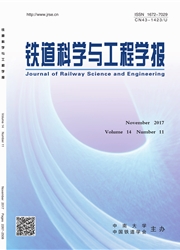

 中文摘要:
中文摘要:
m采用火灾动力学分析软件FDS 模拟空旷隧道、有车辆隧道但无隧道风和有车辆且存在隧道风3 种火灾场景的烟气 蔓延扩散特征,讨论和分析在纵向排烟模式和横向重点排烟模式下,由车辆行皱和通风诱导的隧道风对烟气温度分布及其扩 散距离的影响.研究结果表明:对于纵向排烟模式,由车辆行皱诱导的隧道风可将烟气遏制在整个火源下游区,上游烟气扩 散较少;对于横向重点排烟模式,由卫生通风形成的低速隧道风,亦可遏制部分烟气向火源上游扩散,并能有效降低上游烟 气的浓度,但不如车辆行皱诱导风有效.烟气扩散距离的计算结果则表明,纵向排烟中由车辆行皱诱导的隧道风可将烟气沿 上游扩散距离控制在30m 内,远小于无隧道风情形;而对下游烟气扩散情形,隧道风则显著增大下游烟气的扩散速率.在 横向重点排烟中,由卫生通风形成的隧道风对遏制烟气向火源上游扩散有一定作用,但不利于火源下游集中排烟.
 英文摘要:
英文摘要:
Numerical simulations based on FDS were carried out to investigate the smoke movement and its temperature distribution in an urban road tunnel. In order to examine the impacts of tunnel wind on smoke dispersion, three tunnel fire scenarios, which included the empty tunnel, tunnel with static cars and tunnel with running cars, were used for comparisons in the longitudinal and the transverse smoke extraction system, respectively. The results show that for the longitudinal smoke extraction system, the smoke is fully controlled in the downstream of fire source due to tunnel wind induced by the vehicle movement; while for the transverse smoke extraction system, which is applied in the case of traffic jams, the low-speed tunnel wind induced by the ventilation can also effectively contain smoke spreading toward upstream. The calculation results for smoke spreading distance from fire source indicate that the vehicle-induced wind can contain smoke spreading within a upstream distance of 30 m from fire source in the longitudinal smoke extraction system, which much less than that in cases without this tunnel wind; while the vehicle-induced wind significantly increases spreading speed of smoke toward downstream. When the transverse smoke extraction system is employed, the ventilation-induced tunnel wind helps restrain smoke spreading toward upstream as well, but against extraction of smoke in downstream.
 同期刊论文项目
同期刊论文项目
 同项目期刊论文
同项目期刊论文
 期刊信息
期刊信息
